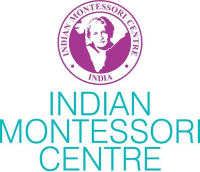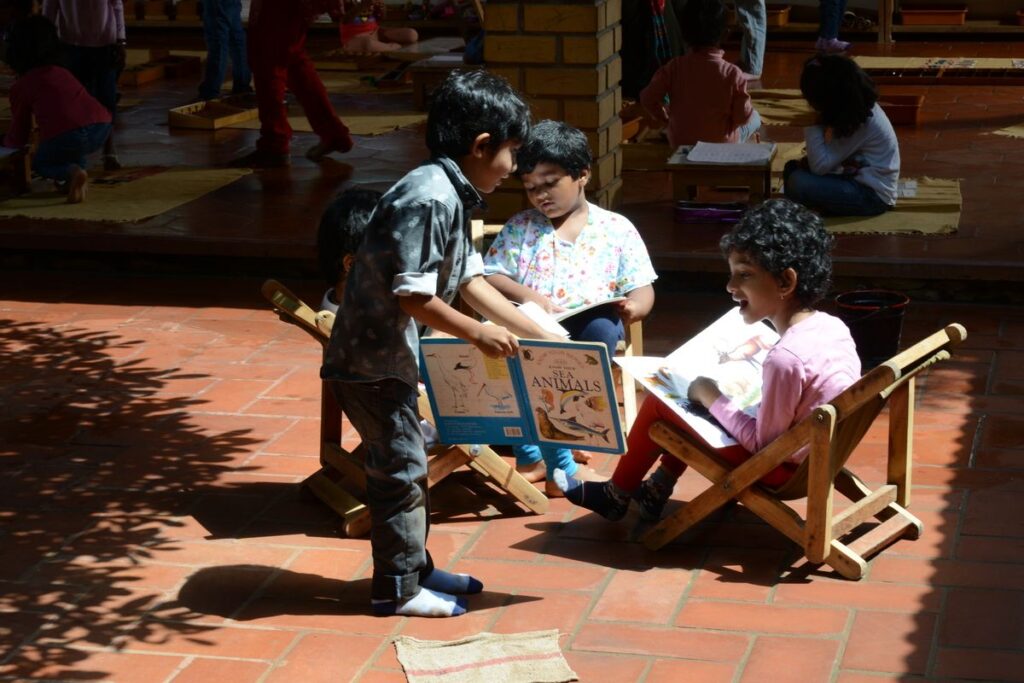Friends
Very often interspersed in my talks I mention certain ideas that have come to us from our previous generations. I have been asked to bring them to an official format. At the outset I want to say that these not a result of deep and long research but mere random thoughts that I find parallel in Ancient India’s thoughts and what I learnt under the banner of Montessori.
The clarion calls of our ancestors who had discovered some truths and they could shout form the top of the hill. as it were “ srunvanthu viswe amruthasya puthraahaa” What they discovered, what they enjoyed, what they wondered at, was all for the whole world.
The first few talks in our training centres are about becoming members of the Montessori family. The so called family belongs to the whole world. It is interesting to see that while Dr. Montessori was alive and after she went the method has gone to many parts of the globe. It is also interesting that she talks about ‘The Child” who is anywhere and everywhere in the world. She shared what she experienced with everyone in the world.
It is usually thought that when people desire to do something they act on it and then learn from it. Be it sports, be it art. Do and Learn is the accepted mode. But strangely Dr. Montessori is the one who wants to introduce the Exercises of Practical life in an educational environment. It was also strange to us when we did the course. Why the school would teach what the child should learn at home. Mr. A.M.Joosten, who is my guru would start the lecture saying’ The child already knows about it but we help him to put all his main powers in the same stream. So it becomes Desire, Knowledge and then Action. It took me some time to digest it. Then it was I remembered that ancestors had said ichcha shakthi, gnanasakti, kriyasakti and in that order. . Thereby knowledge became wider and more fulfilling. We can see the same thought reflected when we talk of the exercises of practical life Time and again we say that the Practical life is not only for helping the child learn the life skills. But it is the most wonderful opportunity given to the child for entwining the three cables as it were to make a strong cable. Covering all the three will be the work that the child does each separately and all together.
This was done years ago. Classifying the work done by Man, they said ‘some work is done as routine, some work is done with a motive and some work because one desires o do it. As all of us can think about our every day work in favour of one’s own self or the family. Mind may be somewhere else but what to do? The work has to be done. It is what we have to do. That is equated to nitya karma. But sometimes we have to do work because of a particular occasion. It need not be only festivals but also not so happy work, perhaps, of assisting a sick person. Good or bad, happy or otherwise these are done with a purpose in mind. This is termed as naimittika karma .
But there are others that we do because we want to. Day or night, fair weather or foul we would do them. The sense of time or place is lost. It feels like we are in a different world altogether. A sense of great satisfaction and bliss is the experience at the end of it Or else it is done expecting a result. We could term it Kaamya karma
Dr. Montessori describes the child in a House of children admitted before he is three years old gets into the stride of living in this new environment. This we term as’ getting settled’. The presentations start and purpose of activities is known. It may be that of greeting or even taking the footwear off before entering. They can be classified as the ‘nitya karma’
Once the child is well settled and develops a sense of belonging then the ‘House of children ‘ is his. This happens after almost a year of his living in the House of children. When something spills he is there put things right. The children plan a ‘salad day’. You see many of them participating in various roles mostly self appointed. There are other celebrations in the House of children needing a lot of work that are not done every day. ‘Naimittika karma” we can say.(Montessori’s example of gathering colour tablets)
The most interesting part of the adults’ work in a House of children is when the child thinks of his own activity be it writing, be it a science experiment. Very often the child plans and executes some activity that has not been presented to him. I remember an incident quoted to me. A child writes her own problems in fractions and solves problems in fractions. The mother is annoyed in the beginning because she does not come to the dinner table. Later that changes into one of wonderment because the child was not doing homework given by the teacher but her own creations. Totally involved. Completely immersed. An instance of Kaamya karma- working towards a goal set by one’s self.
Yaththa shikhaa mayuuraaaaaNaam naagaanaam maNayo yatha
Thathaiva yOga shaastraaNaam gaNitham muurdhani sthitham
Moving away from the child’s work attitude we also find that Ancient India had an arithmetical system that is totally a photocopy of the decimal system. The students in our training courses are amazed when they see the list of names that go up to 10 to the power of 10.The system of calculation was the brain child of people whose life was simple but thinking was of the high order. The simplicity and the regularity in the system was what prompted them to devise it. Though we acknowledge that Dr. Montessori did not invent it we do wonder how she thought it fit to be presented to very young children. It makes us feel dazed that she could make it very practical by devising materials for it. The concept of combining geometry and arithmetic together is stunning for those who learn it for the first time. Our Arithmetic teacher was different from the geometry teacher and so we registered them in different compartments. To bring them together left us speechless. Persons who have the time and energy to study the mathematical genius of yesteryears would accept and enjoy the way Dr. Montessori presents mathematics to the young child in an interesting way that the child learns without knowing that he is learning. She pushes the child on the tarmac so that he takes off to great heights to fly
There is always a loud debate among scholars where “Zero’ originated. Many many years ago the Indian brain thought of Shoonya or poojya in its gaNitha sastra that was considered topmost of all knowledge. In those days, probably there was no recording possible. In spite of that they had the concept of zero. .But Dr. Montessori has offered the idea about zero very clearly by means of educative materials. How admirable it is that she brings out to the child that zero means nothing and therefore not countable. But yet there is an absolute need of it when writing numbers especially that are decimal in nature. When it was presented to us at our training course we sat stunned and mesmerized at the simplicity of the material that brings out a profound truth.
The ancient scriptures talk of human language as born out of Omkaara dhvani. Sanskrit the language of long long years starts with the introduction of sounds in the spoken language by the spots in our vocal system where they originate. The language had obtained a top status even when it was not necessary to write. Taittriya Shikshaavalli talks about
‘Om Shikshaam vyaakyaamaha
varNaha svaraha. Sound and the pitch
mAAthraa balam stress or effort in articulation
saama santhaanaha—- uniformity in pronouncing
ithyukthaha sheekshaadhyaayaha
The importance Dr. Montessori gives to sounds, their analysis, and their succession in words is worth noticing. It is confusing to the students of the training course when we say that the moveable alphabet is a material that helps the child to analyze words into sounds. And not a help to write. That the child gets help for writing is incidental. This activity originates from words that the child already knows. So it is not difficult for the child to turn the spotlight to the sounds. Many are the examples that I can quote how some of us cannot utter certain sounds in the language because we did not hear them when we were young.
Several Montessori workers, having worked with children, have coined the phrase’ Children write phonetically” Especially with English. Of course they will, later on, learn the accepted spelling. t is also interesting that the y can analyse any word in any language . They can write words in one language with the script of another language. The underlining factor being that all languages are made up of sounds. In my school in Chintamani a boy showed me something he had written. Roman alphabet, of course. But I could not make head or tail of it. I accepted defeat. He had written about himself in Konkani , his mother tongue-but in Roman script.
It is not difficult for us Indians to understand the phrase “ Karna paramparaa” Knowledge, words, language all handed down from generation to generation via the ears meaning sounds. Is there anyone who has forgotten how we committed spellings to our memory? Leave alone the punishments we got for that? Indian thought of a process that is most suitable for human nature and so did Dr. Maria Montessori!
When I ask students whether they know of any educational system that is indigenous to Bharatha Varsh most of them would “Gurukula” Ask what it means. The answer is “Live with the Master and learn” Beyond that very little is known. Almost nothing about the educational methods adopted. Time and occasion not permitting I would not be able to give a detailed version but I shall epitomize.
This method of education was the same whether students were princes or paupers The first period is known for education that is ‘Adhi sheela’ The boy learns all that is necessary to live s human being, This directs itself to learning what needs to be done to live as a Man and also learn to live with others. No task was inferior. It could be helping the Gurupatni or take care of the needs of the master. The second stage starts when the Guru accepts that the student has benefitted by the work done in the stage. It is not necessarily by age.
The second stage is known as Adhichitta. Having mastered the way of living as a human person it is time to direct the energy to intellectual conquests. The Master is eager to impart and the student is absolutely engrossed.’ Samithpaani” is the language used to indicate a state of surrender to the Guru.
How many years, how many areas of knowledge is determined by the capacity of the student. No tests, no examinations, no pass, no fail. This is the period that takes the student o great heights. He enjoys the privilege of asking questions of any sort in order to gain knowledge. The method allows the student to ask question of any sort. Though classes were held for groups of students the most important was through questions asked ( aprucchaha na kinchitapi brooyaat”) The amassing of knowledge of various sorts is achieved during this period.
The Gurukula system allows another level that is termed as the Adhi praajnya. This stage the learning, experimenting, exploring, arriving at new concepts and testifying them as proven right is the final level at the Gurukula practice.
Even as I talked you must have compared the parallels with the Montessori House of children. The first days when the child gets settled and understands at the House of children is his own. He becomes at home with the new style of living He moves from his being the emperor where everything is done unto him to a state of having to live with other children and learning that everyone has the same rights. Like an ordinary citizen. Can we compare with the first level at the Gurukula?
The next step is long of strenuous work of learning. It happens at different levels at the same time. There is the freedom to ask questions. The Montessori adult may give the answer or find out for him. Very much like the Guru of centuries ago. Perhaps this is the best yet long period of learning. Many persons involved in the Educational field cannot comprehend that a child as young as four or five can involve himself in discovering things on his own volition. They think children learn only when taught But Dr. Montessori , in her work, discovered that the child is an explorer by nature. Intentionally or unintentionally the child discovers various things. Not that they are unknown facts. But the fact still remains that he discovered things for himself intentionally.
In depth study of Dr. Montessori’s work and our land’s ancient wisdom will reveal many other such parallels. Any one among you can launch yourself in this proposition..
Ayam nijaparavithi gananam laghu chethasam. Udaaracharithaanaam tu vasudhaiyaiva kudumbakam
This means The small minded people think: This is mine, this is not mine” But for the great persons the whole world belongs to them” This will be true of Dr .Maria Montessori and the Child she adored
Before I stop I want to pay my obeisance to them





